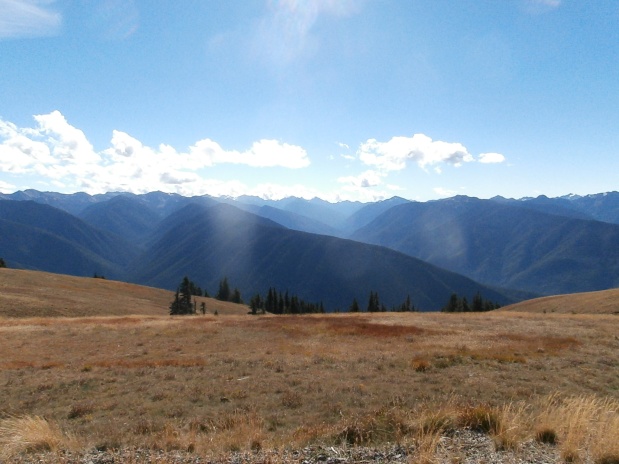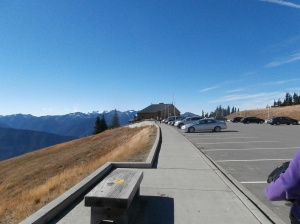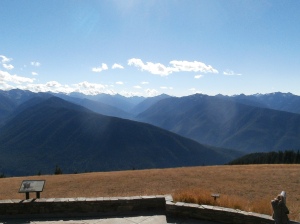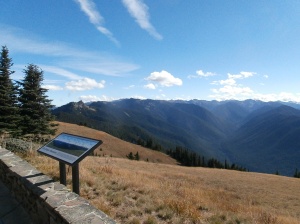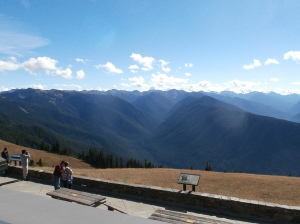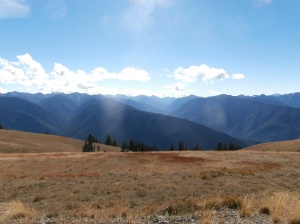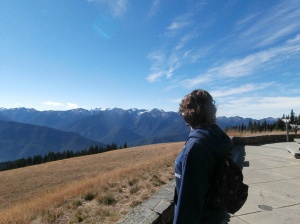Hurricane Ridge. That’s a pretty dramatic name isn’t it? Especially for a site in the Pacific Northwest where we’re not exactly known for our hurricane season. Still the name, for a viewing area in the Olympic National Park, does have a basis. Olympic National Park is situated in the Olympic Mountains, the range that runs parallel to the Pacific Ocean. As the first of two mountain ranges in Washington the Olympics take the brunt of the bad winter weather that blows in from the ocean. In fact this mountain range is the reason that Seattle enjoys such temperate weather—we are in the rain shadow of the Olympics. We also back up against the Cascades so, with two ranges on either side of us, the worst of the weather bounces from the Olympics across to the Cascades and passes right over us. On a side note this weather movement is also why Eastern Washington is much drier than Western Washington—most of the precipitation that starts in the Olympics is gone by the time a weather system gets to the far side of the Cascades.
So that was your Washington weather lesson for the day! Now back to Hurricane Ridge! Given the information above the name of the Ridge actually starts to become a bit clearer—it is regularly subjected to winter storms which include hurricane-force winds—in some of the storms the wind-speed has been recorded at a high point of 86 miles per hour!
You would never know this to visit on a sunny day though–when the weather is clear the Ridge offers some of the best views in Washington! The starting point for the road is in Port Angeles, which sits right on the Pacific Ocean. Do not be fooled by the weather down in town and take it as an accurate representation of what is going on up at the Ridge. At just short of a mile above sea level the Ridge rises above the fogs that routinely closes in around Port Angeles. Often there is clear skies up there if it’s just the usual daily fog—though fog at the foot of the mountain can ruin some of the viewing chances up top.
In fact the Ridge is so high, 5,242 feet above sea-level, that it is safely in the sub-alpine zone. This mean that you’ll have new types of weather and conditions to face as you head up Hurricane Ridge Road to the summit. At any time of the year it’d be a good idea to check on the Olympic Park website or at the ranger station at the foot of the road before you make the drive up. Rock slides or avalanches can block the road at any time of the year and also, depending on the season and current weather conditions, tire chains might be needed to make it up the road. In these upper levels of the Olympic National Park snow can come at any time of the year and many of the hiking trails keep snow on them into July!
Once you make it up the road though, on a sunny day, the views are amazing. I nabbed a few photos while I was up there (You can see them below) but my day was a bit hazy. On a very clear day you should be able to see Mount Olympus, one of the most elusive mountains in Washington State—mostly because it’s rather short compared to some of the bigger ones and it’s out to the west beyond the Seattle/Tacoma area where most people look around for mountains.
If you are into hiking, Hurricane Ridge is a jumping-off point for a whole variety of hikes, from short ones on wheelchair-accessible paved paths to much more challenging ones that only the fittest hiker would want to attempt. More information on the trails and current conditions can be found in the Visitor Center located right at the Ridge. That’s also where you can find a very interesting informative display about the history, geology, ecology and environment of the park. You can find a gift shop and snack bar on the lower level near to the information desk.
I could go on for a good bit longer but, honestly, the majesty of the Ridge and its scenery are best experienced in person. Consider my photos as an appetizer course and then make plans to head out that way yourself! The majesty of the Olympic Mountains must be experienced in person to truly understand why they have awed Humans since people first began to strike inward from the Pacific Ocean.

